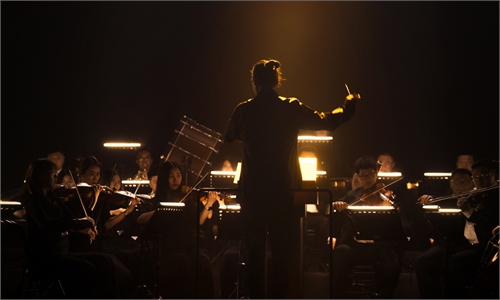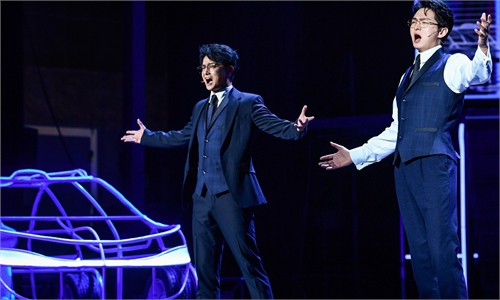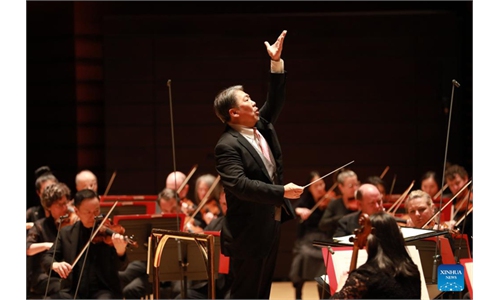ARTS / CULTURE & LEISURE
‘Pipa Goddess’ Zhao Cong shows traditional music elegant, fun for foreign and young audiences
The sound of China
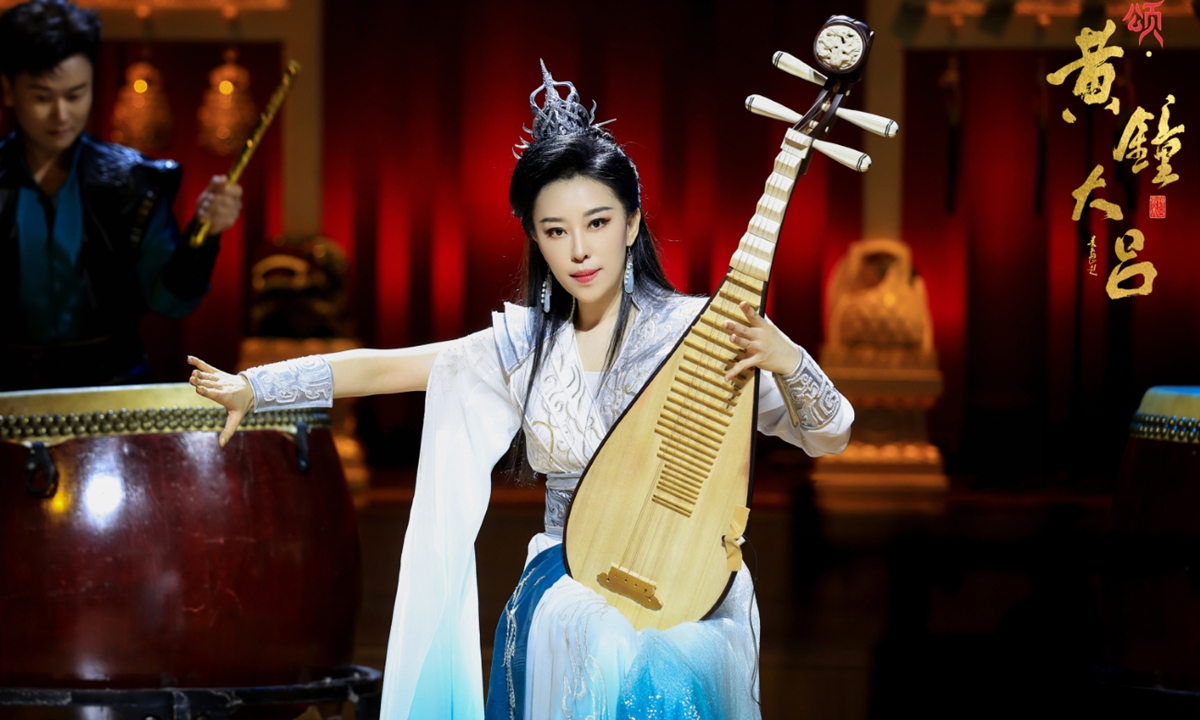
Zhao Cong Photo: Courtesy of China National Traditional Orchestra
Editor's Note:In her hands, the pipa seems to come alive as each touch of performer Zhao Cong makes magic come from the traditional musical instrument. On the stage along the West Lake in Hangzhou, East China's Zhejiang Province, the performance of "Moonlit Night on Spring River" left a deep impression on everyone, from foreign visitors and their spouses to the general public.
As Zhao played, with each pluck of the string, a lamp lit up the quiet West Lake, until the entire lake became a dazzling display of light and color matching the landscape in the background.
The Global Times talked with Zhao Cong, nicknamed the Pipa Goddess, who shared stories of her ties with this traditional stringed instrument and, as a music diplomat, how she uses it to convey the beauty of Chinese folk music to the world.
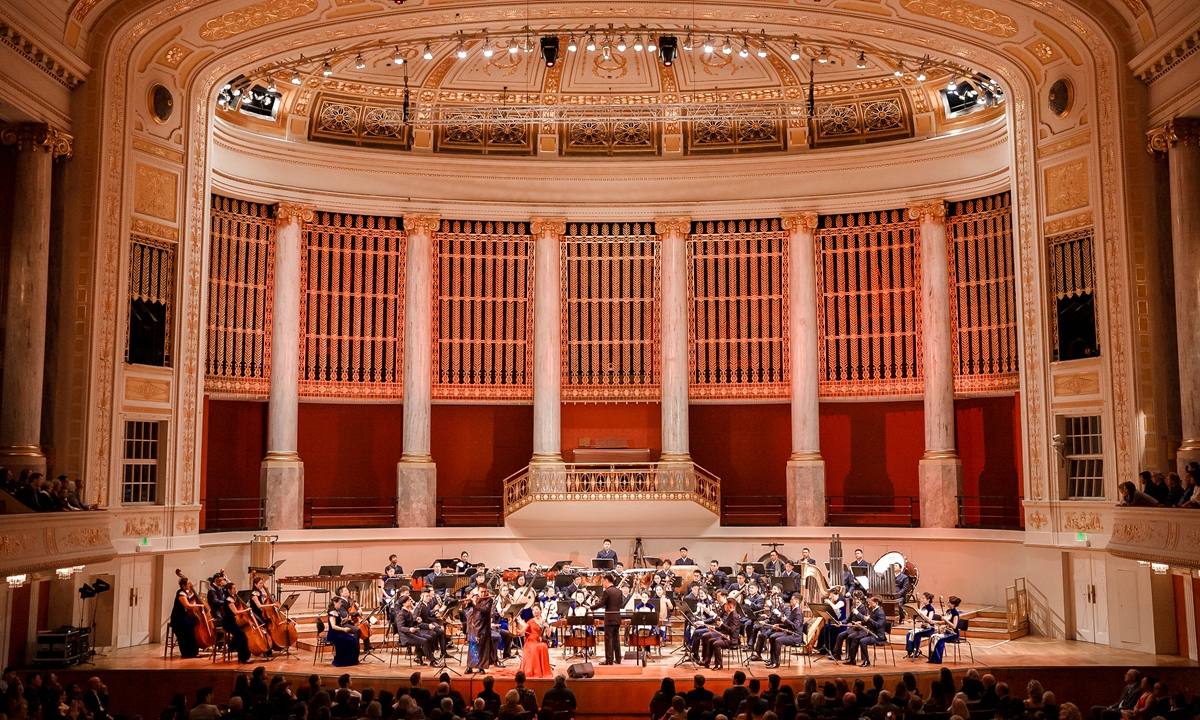
Artists of the China National Traditional Orchestra perform in Vienna, Austria. Photo: Courtesy of China National Traditional Orchestra
Every day is very busy for Zhao. As the president of the China National Traditional Orchestra (CNTO), she needs to deal with rehearsals, performances and daily management of the organization.As a member of the Chinese People's Political Consultative Conference (CPPCC) National Committee, she made a proposal during this year's two sessions to build an international music alliance to promote mutual learning and exchanges among different civilizations.
"With strong cultural confidence, China is coming closer to the center of the world stage, which brings opportunities for cultural diversity," Zhao told the Global Times.
In her eyes, folk music is a good way to communicate with global audiences.
"Music itself transcends language barriers, and our folk music has a history of thousands of years through mutual learning and exchanges with other civilizations around the world. So it is very flexible and inclusive," said Zhao.
'Born for pipa'
The pipa, a traditional Chinese musical instrument, has a pear-shaped wooden body with a varying number of frets, ranging from 12 to 31. The pipa is one of the most popular Chinese instruments and has been played for almost 2,000 years.
Starting at the age of 6, Zhao learned pipa from her mother. Although her elder sister chose to learn the violin from her father, Zhao recalled that she picked the pipa without any hesitation amid other suggestions, like the piano, from her father.
Back then, people thought that learning Western instruments would be more popular. "I have been listening to pipa since my mom was pregnant with me. I feel like the pipa grew in my body. In other words, I was born for pipa," she said.
Zhao's mother started a small art troupe and made Zhao to call her "teacher" in public, the same as the other 10 kids that she recruited. In order to increase the pressure of competition, Zhao's mother always praised the kid next to Zhao, which further aroused "my desire to play the pipa well."
Zhao usually practiced pipa for six hours a day. However, one day, she wanted to challenge herself by training for 10 hours, after which "I felt a little dizzy and had a fever, but I was very happy."
Besides this, Zhao's mother often created chances for Zhao to step on the stage as "so many things can only be learned on stage, not in the classroom."
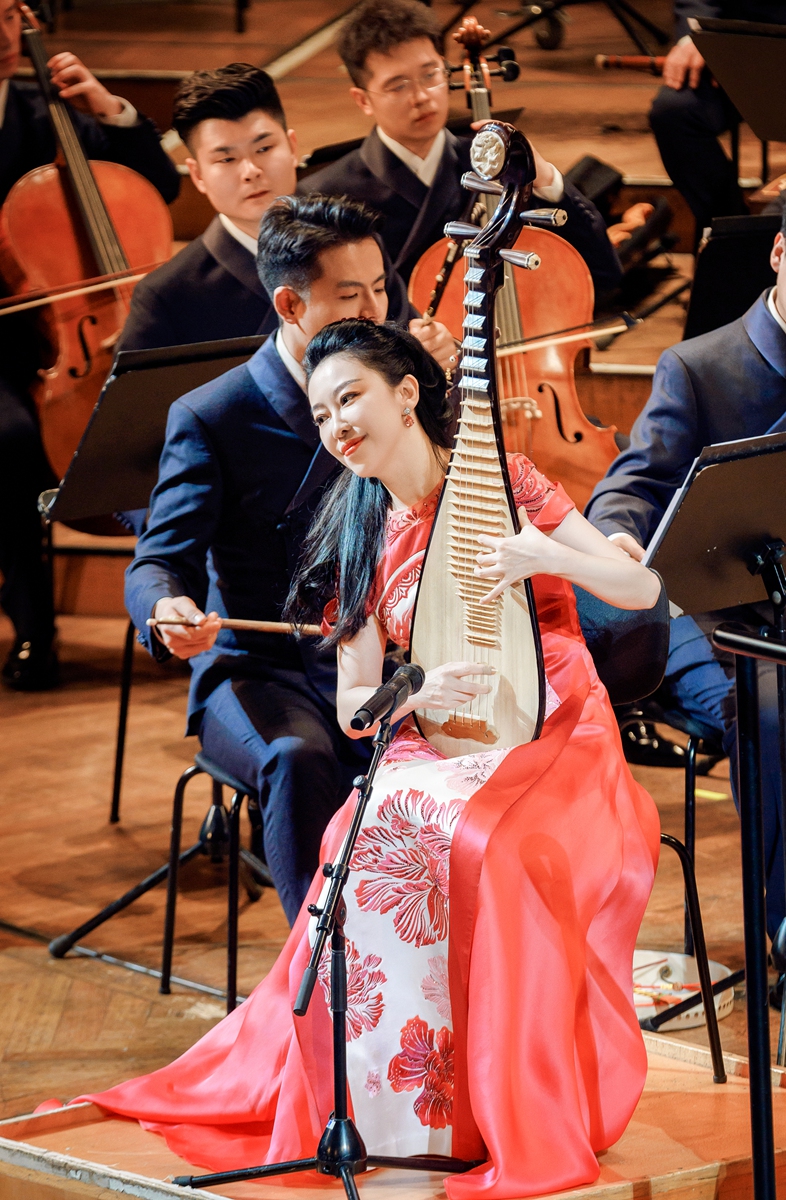
Zhao Cong performs in Vienna, Austria. Photo: Courtesy of China National Traditional Orchestra
From performer to composerBeing a great performer takes talent and luck. That's why not many people who study music can make it. Zhao says she is lucky as she had a good mother and good teachers as well. Her music talent and persistent efforts helped her build her own style and inspired her to become more than a performer.
After graduation, Zhao released her first solo album Carmen, a crossover collaboration between the pipa and the guitar and also her first time taking a hand in composing. The small change opened a new window for her as it would give her more creative space during her next album. The album, Sound of China, was published by Universal Music Group (UMG). It was the first Chinese traditional instrumental music album in the history of UMG. A success, it was collected by the Chinese National Library and American National Library. Jeff Rona, a member of the Grammy Music Awards Jury, said, "Sound of China is the most beautiful traditional Chinese music album I have ever heard."
A majority of the works she has recorded on her world tours have been original works. "Most of them were composed on planes. Musician Tan Dun said that a plane is a place closest to the sky, and so inspiration comes faster," recalled Zhao, who is always seeking innovative ways to promote Chinese music.
"Ambush from Ten Sides" is an ancient Chinese classic music masterpiece that Zhao has played very well since she was 7 or 8 years old. More than 30 years later, she worked with composer Ma Jiuyue to re-arrange the piece, accompanied by electronic music, strong drum beats, and the crystal pipa she made herself.
After graduating from the Central Conservatory of Music, Zhao and her schoolmates formed a group called Music Cat, which included instruments like the violin, cello and pipa. "East meets West forming a universal language that is diversified and interesting" was the group's mission statement.
Seeing the violin was particularly exciting, Zhao started to wonder: If a guitar can be "electric," why can't the pipa? So she invented an electric pipa for her performances.
Zhao Cong strives to integrate folk music with other music genres, so that Eastern and Western musical instruments can find a common ground and produce diverse music.
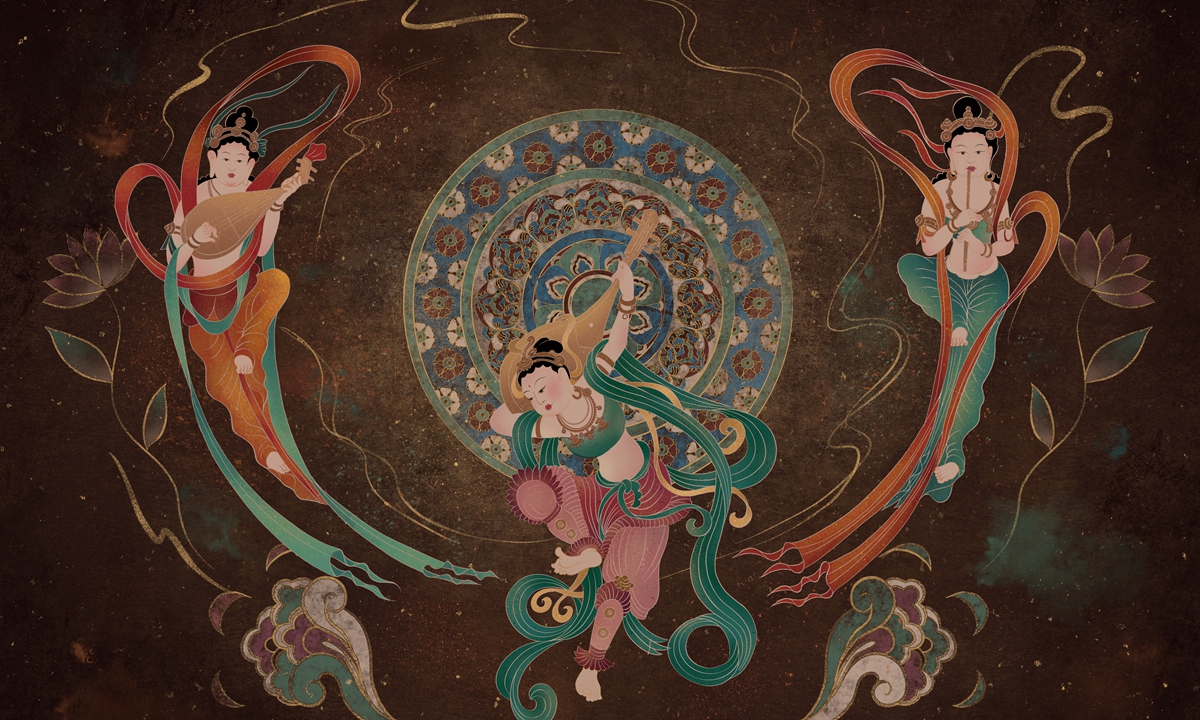
A Mogao Caves mural shows celestial beings playing the pipa. Photo: VCG
Technique from ancient muralThe Flying Apsaras, or feitian in Chinese, are often considered a symbol of the Mogao Caves, one of China's UNESCO World Heritage Sites. The murals in these caves show these celestial beings' attire, musical instruments and other artifacts. The pipa appears in these murals over 600 times, among which the most well-known is a scene in which a performer is playing a pipa while holding it behind her back.
She is actually dancing while playing the pipa. Many visitors to the caves often wonder if this was something musicians at the times actually did or is the painting just depicting something out of the artist's imagination. "But other scenes portrayed in the murals were real, so I believe that this did happen," said Zhao, who has visited the caves.
She eventually had the idea to restage the scene. After various training, including yoga, she finally was able to pull off the move in front of a national audience during the 2022 Lantern Festival Gala using a special tailor-made pipa.
In many people's minds, ancient Chinese music is synonymous with tradition and elegance. Although it has a rich tradition and history, some of its content "is still far removed from the lives of young people." So Zhao suggested that "we need to listen to young people to know what Gen Z likes and then use their favorite ways and true emotions to impress them."
The increasing popularity of Chinese styles and trends proves "the charm and confidence of our culture." It also reminds us to grasp the right opportunity to lead young people into a broader and deeper space of Chinese culture.
A seed grows into a tree
In the past month, Zhao and her China National Traditional Orchestra have toured a number of European countries including France, Germany and Poland so audiences can appreciate traditional Chinese music and culture.
After performing on different stages across the world, she has gained the confidence, strength and thinking to help Chinese folk music go global.
Pipa used to make people think of South China's rivers and bridges. Born in Northeast China's Jilin Province, Zhao chose to create a symphony incorporating pipa and local cultural characteristics from Northeast China, including the folk dance music known as errenzhuan.
After being staged in Vienna and Berlin, audiences stood and applauded it. "They got my music, which shows sincere love for my motherland, my hometown as well as creative ideas," recalled Zhao.
Zhao said that overseas audiences used to think Chinese music is "restrained, traditional and elegant." However, hearing such an exciting and fun piece, they felt very surprised.
Chinese music is a special means of expression for Chinese people. "We pay attention to charm and rely on emotion to boost the development of music," Zhao said, noting that she adds many Chinese music elements to her music when composing, which she calls "little codes."
These "little codes" were a bit troublesome to perform for Russian musicians from Moscow Tchaikovsky Conservatory Symphony Orchestra when they performed a concert at the National Centre for the Performing Arts in Beijing in January.
"Music in the East" is a large-scale pipa and symphony suite that expresses the history of Shanghai's music and folk customs. The third chapter presents scenes including the sound of fingers dancing on keyboards in office buildings and people enjoying their afternoon tea in Shanghai. It is a piece full of rhythm and power. But the conductor couldn't get a sense for the piece based on the notes alone. So Zhao recreated the music by intimating the sound of drinking and moving as well as women wearing high-heels walking along the street.
"They instantly understand it, showing that music is a universal language," she said.
Tradition and innovation are never separated in her music.
"Tradition is the root of innovation. Without tradition, innovation is empty," said Zhao. "Only when you have the seeds of innovation in your heart can the roots of tradition under your feet grow into a big tree."
Zhao has the courage to innovate while inheriting tradition, using new ways of expression that combine the pipa with piano, string quartets and other musical instruments to refresh the public's understanding of traditional Chinese folk music.
"Our Chinese culture is very inclusive, and various musical elements have been well absorbed by the pipa, so now we can play various styles of music with the pipa."
Music knows no borders, and folk music is an important medium for telling Chinese stories well. Zhao says that music is a language that can help people understand Chinese tradition and the world, and build a bridge connecting the two.

